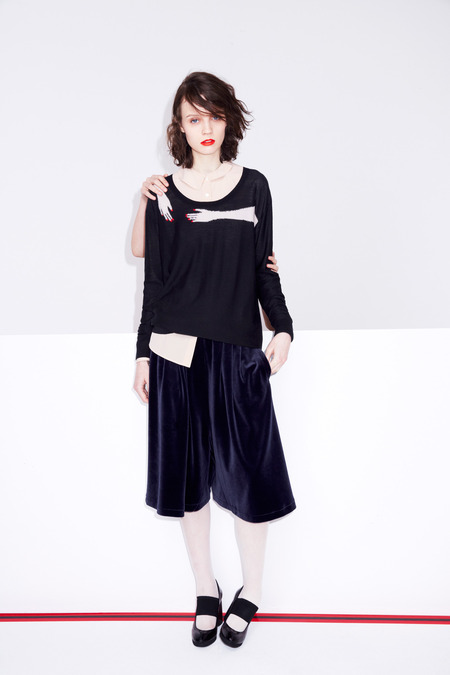Ever since the creation of her eponymous brand, Sonia Rykiel has been imagining clothes that are multipliable, infinitely combinable. The clientele, freed from traditional fashion mechanisms, adjusts the vocabulary proposed to suit their wardrobe. Rykiel is “anti-fashion”. The designer never ceased to talk about unique shapes, and sizes too. “The important thing is to light up the face, liberate the head, to create a climate that highlights it. A garment is a success when people say to the woman: ‘You’re so beautiful’ and not ‘You have such a pretty thing!’ I think that my clothes have that power: making you notice the head without getting noticed. That’s what I want for me and for others… I don’t revolutionize. Never. I evolve. Often imperceptibly.” The techniques of knitwear and jersey established themselves as the major characteristics of her supple style. She was the one who erased clamps, ousted the hems so dear to couturiers that measured fashion in centimeters above the knee, multiplying superpositions, perfecting the unfinished. “Sonia Rykiel’s ultimate revolution was in actions and their significance: turning her clothes inside-out, letting you see the finishings, the seams, everything that was always hidden! And when Isabelle (N.B. Isabelle Weingarten, an actress that walked the runway for the Spring/Summer 1974 collection) undid her jacket to reveal that she was naked, it was neither a striptease nor a provocation, but rather a way of saying: “I have a body, it’s here, like the look under my eyelids.” tells us Madeleine Chapsal in “Sonia Rykiel: le prêt-à-mieux vivre”. Marie-Claire France, Spring 1976.
Sonia would have liked to live in the nude. Later on she would say that she wished that “clothes grew from inside you, like hair, body hair, fur, ideas! Like the wool on sheep!” These intimate confessions are her only formation… After retouching all the clothes she found in the Laura boutique – property of her husband Sam Rykiel, located on the avenue du Général Leclerc, close to Paris’ Porte d’Orléans – Sonia Rykiel asked for a sweater in her measurements. Subject to her demands, this sweater went back and forth between Italy seven times until eventually she borrowed a children’s size that worked best for her, surprising the suppliers. She corrected it endlessly, hollowing out the sleeve under the armpit, diminishing the width of the arm that she wanted to be more tight-fitting, reducing the length to refine and elongate the legs.
In 1968, an article in Elle spent quite a while analyzing the Rykiel phenomenon and announced the upcoming opening of her eponymous boutique on the rue de Grenelle. They compared what a sweater was before she gave it her attention: “On the left, a sweater the likes of which there are still many. Like they all were before Sonia. At rest, they may give off an illusion: the arms over the head test doesn’t forgive. Sonia’s sweaters are just as thin (in the arms and the bust) in motion as they are at rest. The secret: their sleeves mounted extra high up and over the shoulder.” Before her, the knit sweater was cut like fabric. Sonia Rykiel brought the sweater out of domestic artisanship to make it a fashion creation of its own, largely participating in the revival of and the infatuation for the practice of knitting that had disappeared from daily habits since the post-war period. Sweaters but also jackets, dresses, pants, coats, hats, scarves: the whole wardrobe started being made of wool and angora. It was worn right up against the skin. The suitability of Sonia Rykiel’s creations for the women of her generation, preoccupied with liberation, equality, and liberty, was such that in 1972 she came back to the evolution of her style that would henceforth be a textbook classic. She who reinvented the “austere chic”, she who was nicknamed the “Queen of knits” or the new Chanel! Reacting to her coronation as “one of the most elegant women in the world” next to Catherine Deneuve, she replied: “They wanted to reward me, I imagine – in a wasteful society -, for having the courage to wear the same coat five winters in a row!” And to then come back to the changes she hated, that she didn’t see the point of, and to make hers a discourse for the polar opposite male couturiers of her era, still preoccupied with renewal. “Once you find the style that really fits you, and that’s difficult, there’s only one thing to do: cultivate that style. I naturally apply this personal strategy in my field. I make my collections on me, by looking at myself in a mirror, and I would be totally incapable of creating a model that I wouldn’t want to wear for years. It’s the opposite of fashions, that go out of fashion. Everything is in the cut, in the perfection of the details. Of course, shapes evolve, but imperceptibly, without brusqueness and without tyranny.”
Fourty-five years of creation have installed a style that is able to be manipulated with virtuosity to drive clothing towards classics without turning away the gazes of an era from oneself. In 2009, the Grand Palais in Paris hosted a très French fashion show to celebrate the brand’s 40 years of existence. At Rykiel, girls smile, have fun, and joke around. After the theatricality of the rue de Grenelle staircase where Sonia presented her collections that she punctuated with recited poems or thoughts, Nathalie, Sonia Rykiel’s daughter and Vice President of the Board of Directors, up until 2012, had infused the festive joy of her mother back into the mix with a masterful appearance. Choreographer of clothes and allures in motion, Nathalie perpetuated the sentiment of creation where gestures and fashion tirelessly come together with nonchalance, chic, and sensuality; all words inscribed on the knitted lining of these sweaters.

Leave a Reply